FIREFIGHTER PROTECTIVE CLOTHING CERTIFIED FOR STRUCTURAL FIREFIGHTING
Elliotts has been manufacturing protective clothing for firefighters for over 30 years. Structural firefighting protective clothing, sometimes referred to as Turnout Gear or Bunker Gear has come a long way since the first garments we made from wool.
Today, Elliotts' range of Protective Clothing for Firefighters incorporates the latest in fabric technologies and we are constantly re-designing garments to meet the specific needs of our customers.
Elliotts recommends that a firefighter's protective clothing should be comfortable, breathable, lightweight, and highly visible, allow the wearer to move freely, and offer overall protection in the hazardous firefighting environment.
CERTIFICATIONS
Our full range of Structural Firefighters' Protective Clothing is certified to AS/NZS 4967:2019 Requirements and test methods for protective clothing used for structural firefighting. We manufacture certified structural firefighting clothing in our Australian factory.

CLOTHING CONSTRUCTION
Structural protective clothing is constructed of multiple layers of materials. Each material has a very specific purpose. Construction must include an Outer Shell, Thermal Liner and can be constructed with or without a moisture barrier.
- System A - Outer Shell/ Thermal Liner
Garments utilising an Outer Shell and Thermal Barrier do not include a Moisture Barrier. The construction type is preferred when penetration by liquids is not a risk and the work environment is very hot and high breathability is a priority.
- System B - Outer Shell/ Moisture Barrier/ Thermal Liner
This construction utilises the Outer Shell, Moisture Barrier, and Thermal Liner to provide a higher level of protection that is preferred when penetration by liquids is a risk.
REFERENCE PAGES:
Firefighting Protection Introduction | Firefighting Protection Materials | Firefighting Protection Garments | Wildlands Firefighting | Firefighting Protection FAQs

